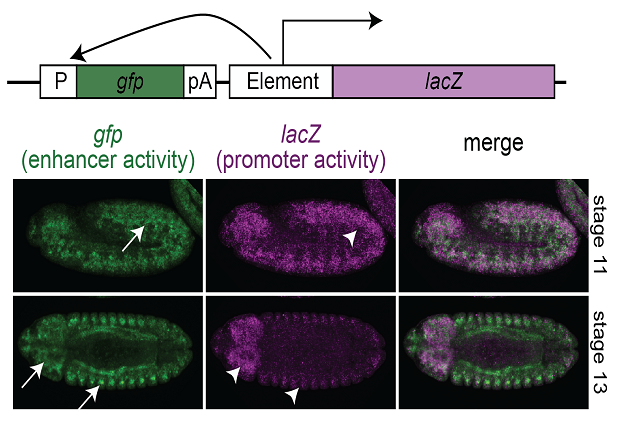
Multipurpose enhancers and promoters in embryonic development
EMBL scientists show that some promoters can act as enhancers and vice versa

During gene expression, the information stored in our DNA is transcribed: turned into instructions to produce RNA and proteins that perform specific functions within each cell. DNA regions called promoters are located at the beginning of genes, and determine the starting point where transcription is initiated. Other snippets of DNA called enhancers control when and where specific genes are expressed. Enhancers are often located far away from genes and must relay their regulatory information to a gene’s promoter.
Now, Olga Mikhaylichenko and colleagues in Eileen Furlong’s group at EMBL have gained new insights into the role of enhancers and promoters during embryonic development, a life stage where very tight regulation of gene expression is essential. Furlong explains the main findings of the paper, that explores the balance between enhancer and promoter activity within individual regulatory elements in vivo, and that was published in Genes & Development on January 29.
What is the key finding in this paper?
It used to be thought that there was a black-and-white distinction between enhancers and promoters: they can only act as one or the other. Our paper shows that there is actually a large grey area in-between, with elements that can perform both functions to varying degrees. The level of enhancer or promoter activity is reflected by both the amount and the direction of transcription from the regulatory element, so whether the element can be read in one or two directions, unidirectional or bidirectional. We also developed a new framework to measure enhancer and promoter activity for the same element, in the same embryo (see figure), which we suggest should become the standard for future studies.
Why is this important?
First of all, we were able to show that things are not as black and white as they seemed. Enhancers and promoters are in various states of evolution with some having exclusive promoter function, others having predominantly enhancer function, and yet other elements, distal enhancers, having weak promoter activity.
One of the findings that I am most excited about is when we looked at activity in the other direction, asking if gene promoters can act as developmental enhancers. Here, we found that promoters that are bidirectionally transcribed can function as both strong enhancers and promoters, for the same gene. This suggests that they regulate both the levels (promoters) and spatial expression (enhancer) of the gene. Interestingly, promoters that are unidirectionally transcribed cannot perform this function.
Hints from other studies suggest that these general features are conserved from fruit flies to humans. Our findings uncover a new aspect of promoter and enhancer function during embryogenesis, and provide interesting insights into how these elements might have evolved to regulate robust embryonic development.


